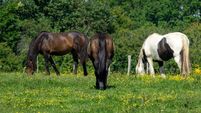Late grazing can be great for the first cut in spring, but know when to stop

This extended grazing season has been a great boost but there may be hidden pitfalls to continuing to graze on much longer.
Many have submitted to temptation and have gone back into fields that they had closed for the winter.
Undoubtedly growth has been fantastic, however you really must draw the line somewhere.
Are animals performing as you require from November grass and what grass will you have left for the spring?
Most have plenty of fodder saved for the winter, so it is not likely that you need to over stretch the grazing season for fear that you will run out in the spring.
Obviously if you farm is lightly stocked then you can afford to graze on as demand will not be high in the spring.
However if you are going to be heavily stocked at turn out next spring you need to consider housing the remaining stock.
Obviously it is better to get very heavy covers off the paddocks in order to insure sward quality next spring.
If you are exclusively grazing silage fields then that is a different story as next year’s crop will benefit from being grazed tight in the backend of the year.
In fact it is evident that those who graze silage ground tightly in November without doing damage rather than grazing it in the spring, tend to produce an excellent 1st cut each year.
This is down to being able to take a much earlier cut as the ground will all have been closed off before Christmas.
Most of the animals that remain out grazing are weanlings and unless they are being supplemented with concentrates they are not achieving growth targets.
This is more of an issue if these are heifers you intend on bulling next spring.
They need to be growing well in order to reach sexual maturity and begin cycling well in advance of the breeding season.
For bulls or bullocks you intend on selling next spring any reduced weight gain now will significantly lower your sale price.
There are a lot of different mineral specs out there.
Minerals are an important part of good ruminant nutrition and can play a key role in animal performance.
Don’t just buy any old minerals for your stock.
Insure that the mineral you buy is fit for purpose and will compensate for any mineral deficiencies in your silage or any that have historically been an issue on your farm.
Above all, please don’t listen to those that tell you that finishing animals don’t need any minerals, they usually come out with, “sure they will be dead soon”?
That is irresponsible advice and has no basis in sound nutrition.










